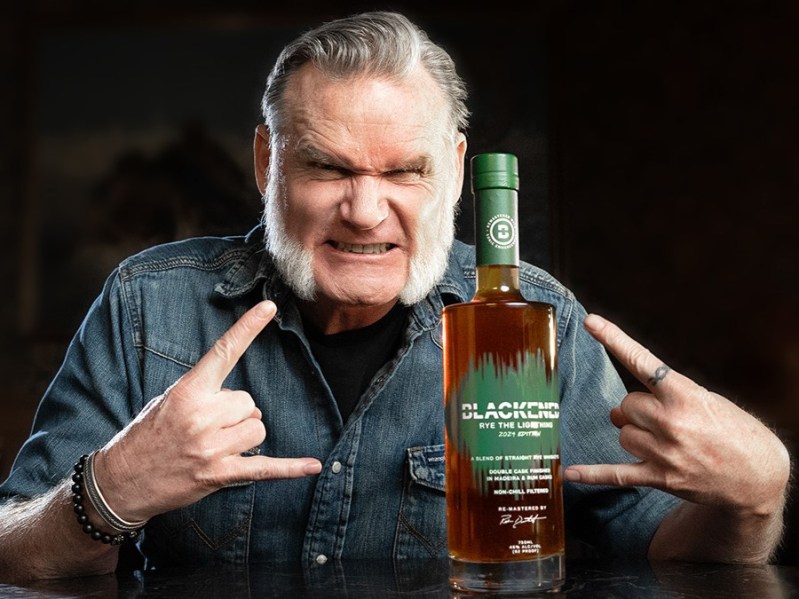
Hush, little reader, don’t say a word, and never mind that noise you heard. It’s just a man inside his den, smoking cigars and learning to blend. You’re probably wondering why I’m opening this feature with a play on Metallica’s Enter Sandman. Well, there are a couple of reasons for that.
First, Rob Dietrich, the master blender I had the amazing opportunity to talk with, has many ties to the band, like his new Drew Estate-coopted S84 Shade to Black cigars and Blackened’s Rye the Lighting whiskey, blended by none other than the expert himself. But also, as far as I’m concerned, the man is a legend and a rockstar in his own right. Metallica also owns Blackened, a fine little detail that can’t be missed.
There I am, nervous but excited to be on a call with someone so established, and Dietrich appears like an electric riff on the wind. You’d think someone that prestigious would open by talking about nothing but his brand and his mission, hoping to get it over with, but no. Humbly, the very first thing he does is compliment my outfit. Taken aback, I share the [corny] yet personal reason why I love the shirt I have on, which might not be that exciting, I’ll admit, but it highlights just how approachable and down-to-earth Rob is. I’m not the type to fawn over celebrities or overlook the flaws in people, but I am certainly the type to celebrate wonderful traits, especially when it makes the experience so much better. I think it’s evident in many ways that Rob is a dark soul, much like me, but that certainly doesn’t make him any less congenial. During the interview, he even showed me how to start a Zoom reaction by throwing up the horns, which kickstarts some visual effects.
It didn’t take long for him to settle right in and light up an S84 Shade to Black with its gorgeous Connecticut wrapper. I already lit mine, so I held it up for pseudo-stogie cheers. From there, we were off to the races.
A journey into whiskey blending, cigars, and perfect pairings

I think it’s important to point out that while we did spend time virtually smoking Blackened’s new cigar label across from each other, Rob is very much in the whiskey and distilled spirits camp. Of course, it’s not a giant leap into cigars — after all, whiskey and cigars make excellent pairings. However, the collaboration with Drew Estate has meant that Rob can leave the cigar blending and craftsmanship to the experts in that trade while focusing on his strengths.
I commend that approach, especially considering it resulted in some fantastic cigars. Drew Estate did a wonderful job blending the Blackened-label cigars from the M81 to the new S84. The Blackened M81 , as you might expect, is a dark Maduro blended in a collaboration between Johnathan Drew, James Hetfield — yes that James Hetfield — and Rob Dietrich. The new S84 Shade to Black is a Connecticut-wrapped cigar blended by the same badass crew. Creamy, delicious, and one hell of an experience are some phrases I would use to describe the Blackened label cigars.
Shop Blackened Cigars by Drew Estate
But alongside the savory cigars, I was also given a handle of Rye the Lightning to try — Dietrich’s Metallica-inspired rye whiskey. My initial sip was bursting with flavor, giving me a limited idea of what Master Blenders genuinely do.
After brewing, Rye the Lightning’s batch was vatted and transferred to Madeira wine and Caribbean rum casks for two to 14 weeks each, infusing them with delicious, fruity flavors. But also, the mix is treated to the brand’s proprietary BLACK NOISE™ sonic enhancement process, which rapidly ages the product. Think of it as achieving a long-drawn-out aging process, where whiskey would otherwise sit for years and years but in a fraction of the time it usually takes. I remember seeing something like this on the A&E show Moonshiners, but it’s practically leveraged to create premium, drinkable whiskeys, in Dietrich’s case, rather than just being for show.
Shop Blackened American Whiskey
But let’s get into the blending of the real batch: Rob’s intriguing answers.
Learning from a Master Blender: Dietrich in action

Naturally, one of my first questions was how Dietrich begins his whiskey blending process when creating a new batch.
“I generally have an idea of where I want to start. Then I might have a variety of ages of whiskey that I’m working with.” Dietrich also credited the whiskeys or blends he might have on hand. It makes a lot of sense that a Master Blender using a variety of whiskeys to create a new blend — even from other brands — would be somewhat limited to what he has within reach.
When it comes to creating the next best blend, Dietrich follows a process, namely the spirit of the whiskey drinker’s journey.
“I want to draw the palate in, bring it up to a peak, and then do a nice long finish. And then layer flavor all the way in between on that journey.”
At the risk of merging the two interests here, it’s very much like the experience of a cigar. After you light it, burn through the first and second thirds, and smoke into the home stretch, the flavors will change, maybe in subtle ways, maybe in significant ways. It’s a journey, and you’re along for the ride. But as the smoker, or in Blackened’s case, as the drinker, we often don’t put much thought into these journeys — that’s precisely what Master Blenders do.
“With Blackened whiskey, I lean into cask finishes. So, I’m going to start with an idea of a base whiskey. Get myself to that base whiskey and then start playing around with different cask finishes.” He points to using the Madeira wine casks for Rye the Lightning and even discusses some of the difficulties of sticking to that plan. Sometimes, he might have an idea for something, like aging in the Madeira wine casks, but acquiring the appropriate supplies is not simple or easy. Thank the Whiskey Gods that he stuck to his guns there, and likely on other occasions, because Rye the Lightning is phenomenal.
“The beauty and artistry of blending is that I can kind of choose from different profiles from different distillers, so if I have accessibility to those, that’s pretty much going to [dictate] where I can start from.”
New age blending to create a classic experience

One of the most extraordinary things Dietrich talked about was their proprietary Black Noise Sonic Enhancement process that rapidly ages the whiskey. He did say it successfully catalyzes the aging, pushing up production, or at least that’s the ultimate goal. The method actually involves using sound waves to stimulate the batch.
“It’s moving in and out of the wood at a rapid pace, so it’s picking up much more of the flavor in a shorter period of time.”
It’s inspiring to me that he and his team pushed for an innovative process that not everyone may be trialing rather than continuing to blend the old-fashioned way with no modern enhancements. Even so, it’s less about the contemporary and more about the premium, classic whiskeys Blackened delivers. Soon enough, we’ll be sipping on aged whiskeys, blended to taste like it’s gone through dozens or hundreds of years of aging yet completed in a fraction of the time.
“When we started working on Sonic Enhancement, that was something I wanted to know exactly what’s going on in [the barrel]. I wanted to understand the science behind it.”
Of course, Dietrich does a much better job explaining the process and the technology than I ever could, so watch the interview if you’re as intrigued as I was.
Premium, American-blended whiskey done right

There’s something to be said for the experience of the whiskey alone. Blackened’s whiskeys and Drew Estate-led cigars offer an incredible experience, which I felt long before meeting Rob Dietrich. But now that I’ve met the legend, had the opportunity to learn about his blending process and deep dive into his general mindset, I would consider myself a fan. You’re probably not supposed to say something like that, especially when an objective piece is what you want to achieve, but look, I’m not going to deny that I had a great time smoking and talking to the man.
Even though I don’t really want to, we have to wrap up somewhere. So, I’ll just close out by saying I’m definitely excited to see what the Sonic Enhancement achieves. It’s one hell of an innovation, and if you like aged whiskeys, it sounds like a game-changer. In the meantime, I’ll continue sipping on my Rye the Lightning and smoking my M81s and S84s down to a nub.



